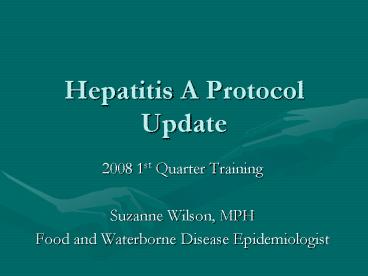Hepatitis A Protocol Update - PowerPoint PPT Presentation
1 / 22
Title:
Hepatitis A Protocol Update
Description:
All cases of Hepatitis A and all IgM HAV lab results are reportable to the LHD ... If exposed to hepatitis A, ask your doctor about post exposure prophylaxis (PEP) ... – PowerPoint PPT presentation
Number of Views:116
Avg rating:3.0/5.0
Title: Hepatitis A Protocol Update
1
Hepatitis A Protocol Update
- 2008 1st Quarter Training
- Suzanne Wilson, MPH
- Food and Waterborne Disease Epidemiologist
2
Objectives
- Clinical presentation of acute Hepatitis A
- Epidemiology of Hepatitis A virus
- Case Definition for acute Hepatitis A
- Public Health Action steps
3
Symptoms of Acute Hepatitis
- Fever (Hep A)
- Malaise
- Nausea/Vomiting
- Abdominal discomfort
- Anorexia
- Jaundice
- Joint pain (Hep B)
- Dark Urine
Recovery is the norm. No treatment available.
4
Epidemiology of Hepatitis A
- Agent
- Hepatitis A virus- family Picornaviridae
- Reservoir
- Humans
- Incubation Period
- 28-30 days average
- Infectious Period
- 2 weeks before and 1 week after symptom onset
- Mode of Transmission
- Fecal-oral, foodborne, waterborne
5
Case Definition
- Clinical Description
- An acute illness with
- Discrete onset of symptoms AND
- Jaundice or elevated serum aminotransferase
levels - Lab Criteria
- IgM antibody to hepatitis A (anti-HAV) positive
6
Case Definition
- Case Classification
- Confirmed
- Case that meets the clinical case definition and
is laboratory confirmed OR - Case that meets the clinical case definition and
occurs in a person who has an epidemiologic link
with a person who has laboratory confirmed
hepatitis A (i.e. household or sexual contact
with the infected person in the 15 to 50 days
before onset of symptoms)
There are no Suspect or Probable
classifications for Hep A
7
Case Ascertainment
- First step in investigation of a reported case of
hepatitis A - Does the case have a () Anti-HAV-IgM?
- Does the case have acute illness with discrete
onset of symptoms? - Does the case have jaundice or elevated serum
aminotransferase levels - Must answer yes to all 3 questions to meet case
definition of acute Hep A
8
Reporting of Hepatitis A
WV Communicable Disease Rule (WV Code 16-3-1
64CSR7)
- All cases of Hepatitis A and all IgM HAV lab
results are reportable to the LHD of the
patients county of residence within - 24 hours of diagnosis
9
Disease Control
- The first priority (!)
10
Infectious Period (yellow)onset jaundice gt
symptoms
11
Control Measures
- Household and sexual contacts
- Educate
- Signs and symptoms of disease
- Preventing transmission
- Administer PEP if exposed to infectious case
within the last 2 weeks - Exclusion from work / school
- Only if symptomatic
12
Prevention
- Prevention messages
- Always wash your hands after using the bathroom.
- Always wash your hands after cleaning the toilet.
- Always wash your hands after changing diapers.
- Always wash your hands after handling soiled
towels or linens. - Always wash your hands before fixing food or
eating. - If exposed to hepatitis A, ask your doctor about
post exposure prophylaxis (PEP)
13
Post Exposure Prophylaxis (PEP)
- Persons recently exposed to HAV (within 14 days)
and who previously have not received hepatitis A
vaccine... - For healthy persons aged 12 mos to 40 years 1
dose (age-appropriate) of single antigen HAV
vaccine - Persons aged gt 40 yrs, IG is preferred vaccine
can be used if IG is not available - Children lt 12 mos, immunocompromised persons,
persons with chronic liver disease, or persons
for whom vaccine is contraindicated, IG should be
used
14
Hepatitis A PEP Recommendations
15
Infectious Period (yellow)If the 21st is the
last day of exposure, the 4th is the last day you
can give PEP!!
16
Control Measuresfor High Risk Settings
- PEP should be administered to all staff and
attendees of a day care center or home if - 1 or more cases of Hepatitis A are recognized in
children or employees - or
- Cases are recognized in 2 or more households of
center attendees
17
Control Measuresfor High Risk Settings
- In day care centers that do not provide care to
children in diapers, PEP need be given only to
classroom contacts of the index case-patient
18
Control Measuresfor High Risk Settings
- If a foodhandler is diagnosed with Hepatitis A
- Appropriate PEP should be given to other
foodhandlers at the same location - PEP administration to patrons may be considered
if - the foodhandler directly handled uncooked foods
or foods after cooking during the infectious
period and - had diarrhea or poor hygienic practices and
- patrons can be identified and treated within 2
weeks after exposure
19
Control Measures
- Health care workers infected with HAV should be
excluded from hands on patient care for 7 days
following the onset of symptoms - In a health care setting
- Nosocomial transmission rare
- Use standard precautions (also use contact
precautions for diapered or incontinent patients)
20
Summary
- Cases and positive labs reported in 24 hours
- Start investigation immediately
- Case ascertainment
- Follow up household and sexual contacts
- Investigate high risk occupations
- Recommend/Administer appropriate PEP
21
Location of Protocol
- http//www.wvdhhr.org/idep/pdfs/idep/hepatitisA/he
p_a_protocol.pdf
22
Questions?































